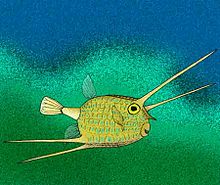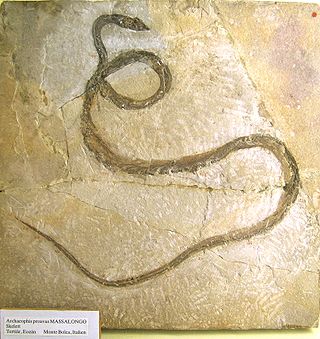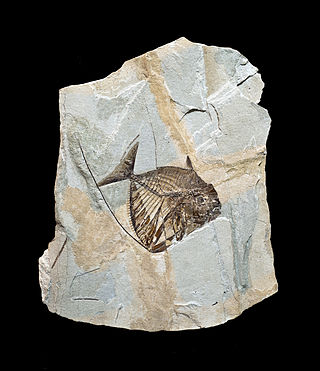
Mene rhombea is an extinct perciform fish belonging to the family Menidae. During the Middle Eocene, about 48 to 40 mya, these fishes lived in the Tethys Ocean, a large tropical sea in the area corresponding to the current Mediterranean. This ocean was extended between the continents of Gondwana and Laurasia. At this time, where Monte Bolca is today, M. rhombea, and its relative, M. oblonga, lived in a tropical lagoon.
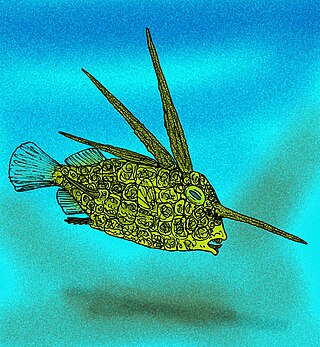
Eospinus daniltshenkoi is an extinct tetraodontid bony fish from the Eocene. Its fossils are from the Danata Formation lagerstatten of Ypresian Turkmenistan.
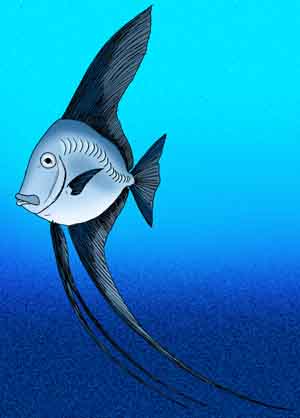
Ceratoichthys pinnatiformis is an extinct species of lookdown-like prehistoric jackfish that lived during the Lutetian epoch, of the Middle Eocene of Monte Bolca, Italy.

Coccodus is an extinct genus of extinct pycnodontid fish that lived during the lower Cenomanian. The various species had a pair of massive, curved spines emanating from the lower sides of the head, and one curved spine on the top of its head. Unlike most pycnodontids, Coccodus species had a comparatively long body, giving the living animals a superficial resemblance to a scaly chimaera.

Proaracana dubia is an extinct, prehistoric aracanid boxfish that lived during the Lutetian of middle Eocene Monte Bolca.

Spinacanthus cuneiformis is an extinct prehistoric tetraodontid bony fish that lived from the Lutetian epoch of Eocene Monte Bolca.
Paranguilla tigrina is an extinct prehistoric eel that lived during the Lutetian epoch of the Eocene, in what is now Monte Bolca.

Bolcyrus is an extinct genus of prehistoric bony fish that lived from the early to middle Eocene.

Ductor is an extinct genus of prehistoric ray-finned fish that lived from the early to middle Eocene. Fossils are found in Monte Bolca.
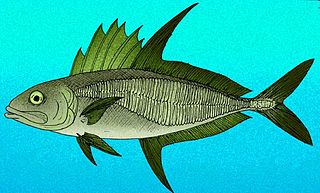
Eastmanalepes primaevus is an extinct species of prehistoric jack fish that lived from the Lutetian epoch, of what is now Monte Bolca, Italy. It was originally described as a species of the jackfish genus Caranx, of which it has a superficially similar outline to. It differs from Caranx, and almost all other jackfish, in that it has very large, very pronounced scutes along its lateral line. According to Bannikov, E. primaevus is probably more related to the extinct jackfish genera, Eothynnus and Teratichthys.
Archaephippus is an extinct genus of prehistoric spadefish that lived from the early to middle Eocene. Several exquisitely preserved fossils have been found from the Monte Bolca lagerstatten.
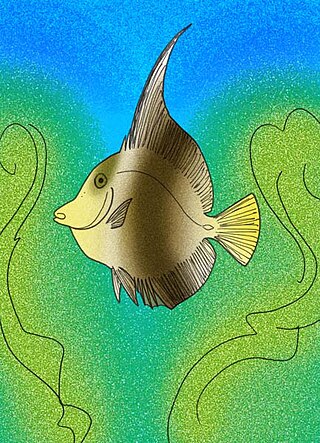
Eozanclus brevirostris is an extinct relative of the Moorish idol that lived during the late Ypresian epoch of the Eocene in what is now Monte Bolca, northern Italy. It differs from its living relative by having a much shorter snout.
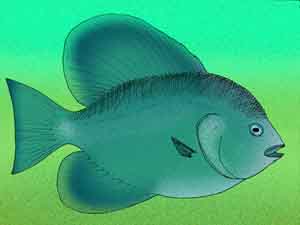
Psettopsis subarcuatus is an extinct, prehistoric moonyfish that lived during the Lutetian epoch of Monte Bolca, Italy.

Tylerichthys is an extinct genus of prehistoric surgeonfish that lived in a coral reef during the Lutetian epoch of what is now Monte Bolca, Italy.

Eoplatax is an extinct genus of prehistoric spadefish that lived during the Lutetian of Monte Bolca. They are closely allied to the extant genus, Platax, more commonly known as "batfish."
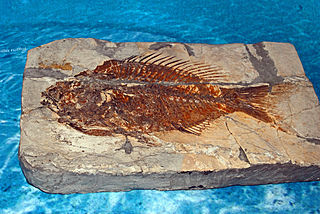
Sparnodus is an extinct genus of prehistoric perciform fish in the family Sparidae. Species of this genus were nektonic carnivore. These fishes lived in the Cenozoic Era, in Oligocene and Paleocene.
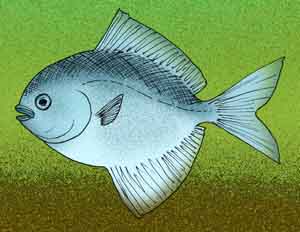
Pasaichthys pleuronectiformis is an extinct, prehistoric moonyfish that lived during the Lutetian epoch of Monte Bolca, Italy. The average length of its fossils is about 6 centimeters. In life, it would probably resemble its living relatives of the genus Monodactylus.

Protobalistum imperiale is an extinct prehistoric tetraodontid bony fish that lived from the Lutetian epoch of Eocene Monte Bolca.

Spinacanthidae is an extinct prehistoric family of tetraodontid bony fish that lived from the Lutetian epoch of Eocene Monte Bolca.
